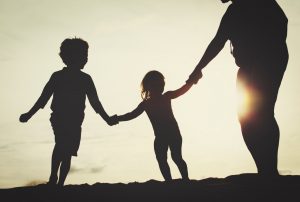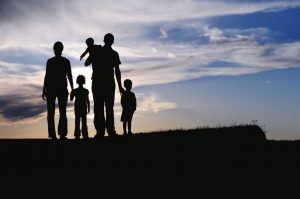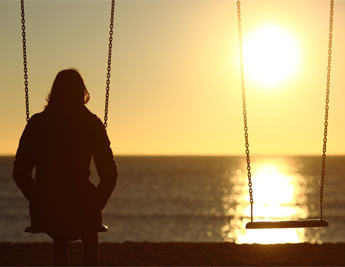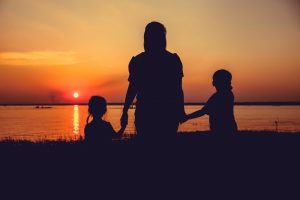With 1 in 5 children living in poverty in the province, you can bet that every British Columbian knows a child who is affected. Children are poor because their parents are poor for many different reasons, but what is universal is that the stress and deprivation of living in poverty have lifelong negative implications for children and their families.
In order to put a human face to the statistics of child poverty, five brave mothers and couples have shared their stories of hardship and resilience. These stories point to clear policy solutions.
For low-income grandmother Georgia, securing enough food for the family every week and accessing public transit are some of the family’s key challenges. “When we see security, we hop off.”
Lynda, a mother of four, struggles to make ends meet while raising her family on her disability assistance, which in turn impacts her health and wellbeing as a parent.
Married couple Sabrina and Shawn Moreau understand all too well the benefits of taking their kids beyond the busy streets of the Downtown Eastside: “I can only access what we can walk to,” Sabrina says, “we really don’t travel on transit—we have to walk everywhere.”
Larsen, a former youth in foster care who ran away at age 13 and began a fight against breast cancer in grade 11, is now a single mother raising two children, aged 4 and 15, on disability assistance in a drafty BC Housing unit in Surrey, BC. She knows all too well the challenges of low welfare rates, lack of quality affordable housing, poor quality childcare, and aging housing stock that drives up the energy bills.
Indigenous single mother Suzanne, 31, was also raised in foster care and now raises four children of her own—including 2 twin boys—far below the poverty line. She says racism against Indigenous people is one of the biggest issues facing her family.
Read these stories, then take action by emailing the Premier. Tell her to adopt a comprehensive poverty reduction plan to ensure that stories like these don’t continue to be so common in BC.
Indigenous grandmother Gloria Bonner faces an uphill battle as a grandparent raising two grandsons with special needs.
Gloria has raised her grandsons—from two different daughters—since they were little. Now 7 and 11, she is coping with diagnoses of mild autism and FASD between them, and raising the boys in poverty on her low welfare income.
Long waiting lists for her two sons are a fact of life for Gloria, a fierce advocate for her grandsons. In order to secure a child care space instead of a spot on a long waiting list, Gloria had to conceal their special needs or risked waiting out the early years on waiting lists.
Grandparents raising grandchildren face complicated bureaucracies – legal, financial and governmental – that are difficult and often expensive to navigate. With two different and complicated legal situations, an ongoing court process, and a challenging relationship with one of her daughters, she needs an enormous amount of support.
Securing enough food for the family every week and accessing public transit are some of the family’s key challenges.
“Both the boys are growing fast, and when you are trying to manage the groceries—we do a lot of rationing. They might want more, but we have to save it to have some for later too,” Gloria says.
Gloria and her grandsons access free meals at community based charities three nights a week to get by.
Yet when it comes to transit, Vancouver lacks any discounts or supports for low income families or children to get out to community centres with swimming pools and visits to the doctor.
“We get bus passes in a good month, nothing other months.”
Unable to afford transit often, Gloria and her grandsons say they have to “hop it” to get to the library or the park.
“When we see security, we hop off.”
“I have faced low income my whole life,” says Lynda Nickerson, who lives in Nanaimo BC with her husband and four children, ages 3 1/2, 6, 16, and 18.
Raising her family on her disability assistance (PWD), they struggle to make ends meet. Lynda’s health and wellbeing as a parent with mental illness is impacted.
“The impact of low income and the lack of supports for mental health are the big problems,” she says. Lack of quality affordable housing in Nanaimo, childcare struggles and minimal extended drug coverage—lack of a universal Pharmacare plan—are key issues facing her family right now.
“What is left over from our basic needs–that is what is left for medications for me that aren’t covered or approved. I needed a sleeping aid recently, but when they told me it wasn’t approved…forget it.”
Lynda says she would like to be able to work, but with her depression and anxiety there are many days an eight hour shift would be impossible.
Effective September 1st, 2017, the province raised the earnings exemption for people on disability assistance. A family with two adults where only one person has the Persons with Disabilities designation can now make $14,000 per year.
Lynda would like to go back to school, but the cost of childcare is discouraging. Plus, the Single Parents Employment Program (SPEI), targets only single parents on welfare. Married or common-law couples are left out.
Complicating matters right now is the fact that the family has been renovicted from their current affordable rental at $1350, and must move by the end of the month. Listings in their unit size are topping $1850–a monthly price tag impossible on their income.
“There is deep discrimination against families,” Nickerson says, “an agent said to me they would rather rent to someone with 20 cats then to someone with four kids.”
Renting lodgings that leak heat and need to be retrofitted, much of their income goes into a $130 a month hydro bill, plus another $130 for gas.
Some welcome relief for the family has arrived in fall 2017. Nanaimo recently made public transit free for up to two children under 14 accompanying an adult who is a pass-holder. The fact that the kids have to travel with a parent is limiting, however, and there is no discount for low income adults.
With the BC Housing waiting list very long and faced with rents they cannot afford, they have no idea where they can afford to live at the end of the month.
Married couple Sabrina and Shawn Moreau are raising their three children in Vancouver’s Downtown Eastside neighbourhood on a fixed welfare income. They speak passionately of the benefits to their family of being able to travel around their city, if only they could. Instead, they struggle to glimpse horizons beyond the busy streets of the Downtown Eastside.
“I can only access what we can walk to,” Sabrina says, “we really don’t travel on transit–we have to walk everywhere.”
She says they would have to take the bus to access the swimming pool or the skating rink, so they rarely do; the walks are too long with their young elementary school aged children and new baby girl. The fresh air and lush green of Stanley Park is frustratingly out of reach.
“If we had access to public transit for the whole family, we’d go to cool events in Stanley Park, or out in Surrey, you hear about these free events for families,” she says.
“It is a scramble to try to get anywhere,” says her husband, Shawn. “There is so much around that is out of reach–community centres, the PNE, Grouse Mountain–but we can’t afford the bus rides after food, paying rent, paying the bills.”
They know how much their kids lose out. If they access transit, though, the kids would have less to eat, and there is already scarcity in the kitchen.
Accessing health care for the whole family is also a major struggle due to their mobility crisis. They are currently searching for a family clinic within walking distance that can take them all.
They find little room for families, however, as local supports respond to the addictions crisis in their neighbourhood.
A former youth in care who ran away at age 13, B.L. Larsen lived on her own from ages 15 to 18, working at McDonalds every day after school to support herself. In Grade 11, she had breast tumors removed and other serious health issues began to emerge including depression, early osteoporosis, and kidney disease.
Now, Larsen is a single mother raising two children, aged 4 and 15, on disability assistance in a drafty BC Housing unit in Surrey, BC. She knows all too well the challenges of low welfare rates, lack of quality affordable housing, poor quality childcare, and aging housing stock that drives up the energy bills.
Too often, she says, she has had to approach welfare and ‘beg’ for an emergency food voucher to feed her family. “They [welfare staff] belittle me so terribly…I have nothing to fall back on. When unforeseen things happen, you are stuck. I had to beg and cry for two hours for a $20 food voucher for my kids.”
Larsen says it took 12 years—8 years on her own and four with her first daughter–before she found a unit in BC Housing with rent tied to income.
Yet aging BC Housing stock is impacting her ability to meet the basic needs of her family to stay warm and fed.
“It’s cold, my son is cold, I want to have the heat up but I can’t. You shouldn’t have to turn your heat off just to make sure you can pay your bill.”
Larson is on the BC Hydro equal payment system, paying $135 per month year round. From December to spring, it costs $250 to heat her home. Just when she needs to keep her family warm, she turns the heat off to ensure her bills do not surpass the fixed monthly amount.
“I keep the heat off as much as possible to balance my bill…my suite has windows, skylights and sliding doors, the cold air comes right in.”
Larsen says the recent $100 raise to welfare only amounts to $10 a year, since the rates had not gone up in a decade. Raising the earnings exemption without a way for her to access a job that works for her unique situation is ‘pointless’.
“My doctors said ‘no’ when I asked them if I could work. I can’t access the SPEI [Single Parents Employment Initiative], it is too much for me.”
Previously, Marshall worked 4-8 hours a week at $10 an hour, which brought in crucial extra income to feed her kids. Then, the company went out of business and she has not been able to find something to replace it ever since.
Even if she could find a way to access the earning exemption, lack of quality, affordable childcare is a huge barrier.
“I can’t afford childcare anyway, so what is the point?”
Indigenous single mother Suzanne, 31, is raising four children–including 2 twin boys–far below the poverty line. She says racism against Indigenous people is one of the biggest issues facing her family.
Raised in foster care by a “racist white family” who rejected her Indigenous identity, her foster parents threw her out at age 13. They dropped her off one night at a shelter for youth and drove away. Abandoned to the streets throughout her youth, Suzanne says she didn’t feel helped or supported until she was a single mother and disaster struck.
“They wouldn’t help me until they apprehended my child because of her dad,” she says, “and then I fought for her.”
To secure the support they need to access transit and childcare, single mothers often have to keep a family support file open with the Ministry of Children and Family Development, Suzanne says.
Her oldest daughter has mental health challenges, and other than some counselling, she will not get the real support she needs until she is fully diagnosed. Her daughter has been waiting 1.5 years for a full assessment. The transportation support she needs to take her daughter to counselling every week on the bus she gets through her support file.
“So basically, I have to have social workers in my life who judge me and my kids and my life to get the supports I need.”
The dangers of unlicensed, low quality childcare she knows all too well. While accessing a home-based unlicensed child care setting, Suzanne arrived one day, accompanied by a social worker she was with, to find her toddler daughter and the other children alone in dirty diapers in play pens. An elderly relative was out of sight on the fourth floor. The caregiver had left them unattended to run an errand at the local drugstore.
‘They [social workers] told me I couldn’t leave her there anymore, of course, but then there was zero help for me to find other childcare, so then I had none. Then they come down on you for being a crappy parent when you have no break.”
Pursuing yoga teacher training full time now, Williams feels that the racism she experienced early in life is what needs to change the most.
“People need to start believing we [Indigenous people and parents] can make it in life,” Williams says.
 Gloria’s Story
Gloria’s Story Lynda’s Story
Lynda’s Story
 Larsen’s Story
Larsen’s Story